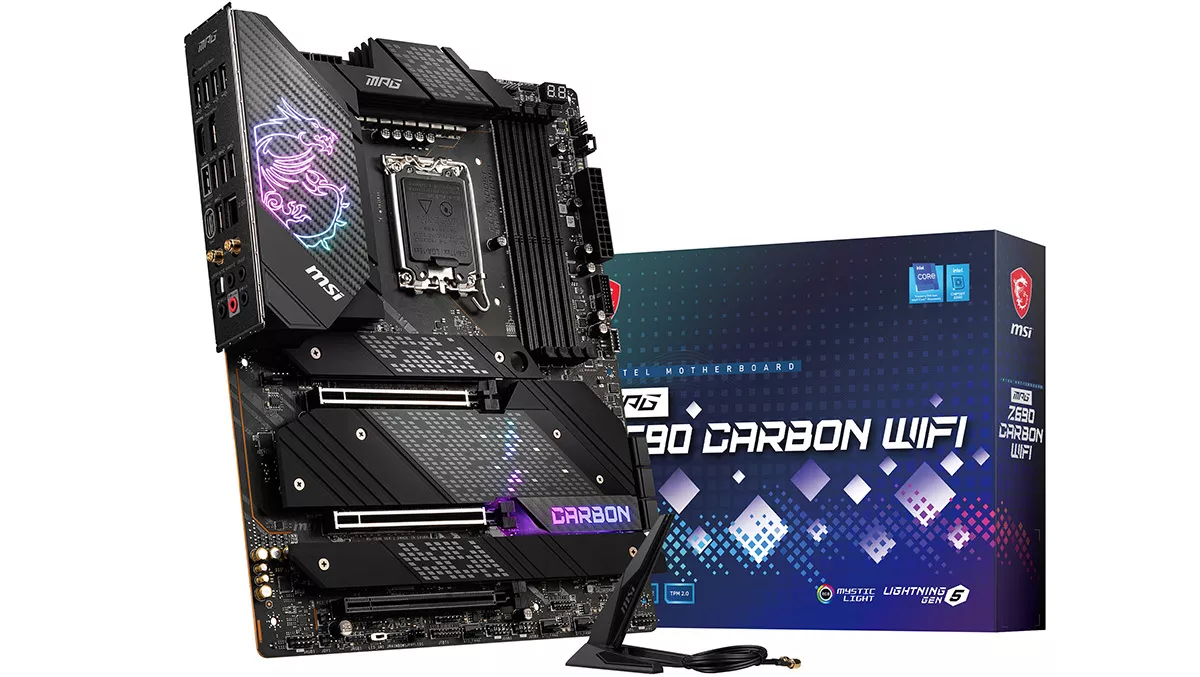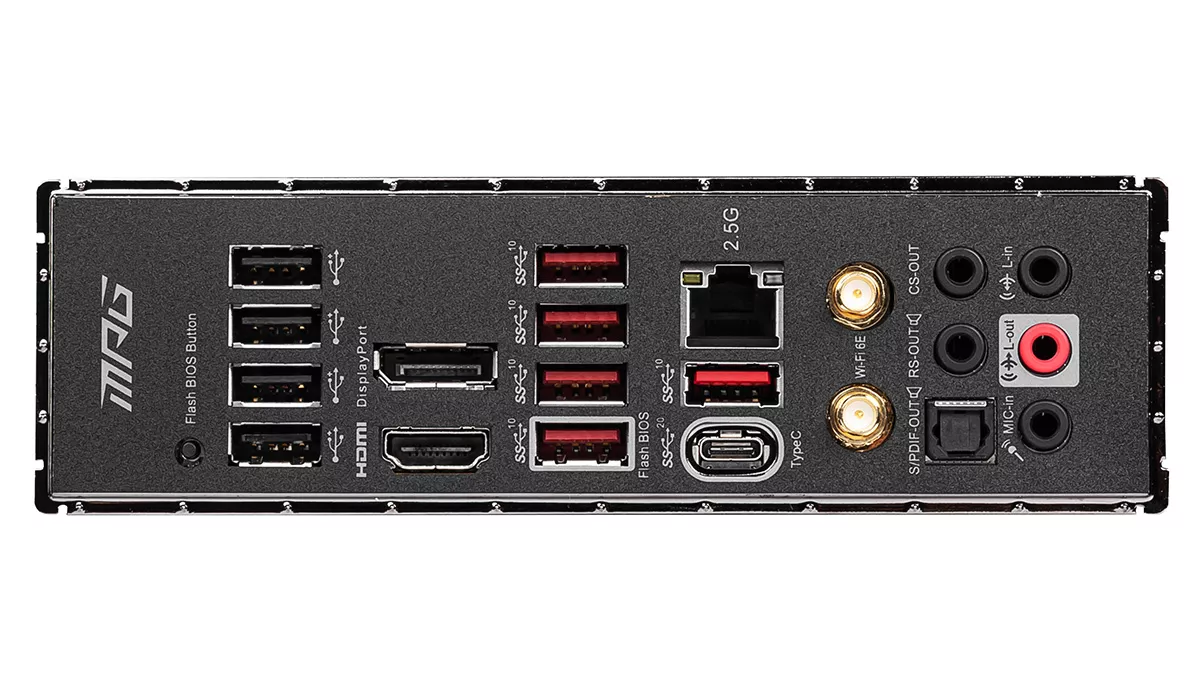
Hands-on review: MSI MPG Z690 Carbon WIFI motherboard
It's all change with Intel's 12th generation CPUs. We have a new chipset in the 600-series, a new socket with the LGA 1700, and new DDR5 memory. MSI's ATX MPG Z690 Carbon WIFI motherboard ticks all the boxes.
It's been a long time since I last installed an MSI motherboard. It's been so long, back then MSI was still branded Micro-Star. So, it was with much excitement that I opened the package, continuing to assess the review unit.
The board's MPG prefix places it in MSI's performance motherboard range aimed at gamers with the aesthetics to match. It should be the MSI range of choice for most PC gamers and sits below the MEG range of enthusiast-level MSI boards aimed at users into extreme tuning.

Whilst the Z690 Carbon WIFI sits in the middle of the Z690 board price range, the box is no flimsy cardboard affair. The motherboard is nicely presented in a box with textured plastic veneer that suggests that you've made a wise choice and that it holds something very special inside.
Opening it up, the anti-static wrapped motherboard is straddled by a small box containing the Wi-Fi antenna. Under the board we have the manual, a quick installation guide, and a registration card. There are also the usual SATA cables, a couple of EZ M.2 fixings, and some RGB cables including one that integrates the board with Corsair's LED lighting.
There's also a selection of extra goodies thrown in to complete the package. There's a sheet of cable ID stickers, another sheet of customisation stickers, including some for the motherboard battery, and a very fancy MSI logo badge for your chassis.
MSI has also thrown in a set of mini-screwdrivers and a fancy little dual-headed brush. The best, I've saved till last: there's a little MSI-branded USB with all the board's drivers on it. Yep, some five-ten years after placing an optical drive in a PC became a little quaint, there's no obsolete plastic disk in the box, and no need to either find a way of transferring the files onto a USB or fish around on the company website for a set of drivers. Top marks, MSI. It's the future, today.
Flicking through the manual, it's easy to read with all the information exactly where you'd expect. There are detailed and clearly illustrated directions for installing PC components and the location of connectors.
The board itself is pretty unassuming. The black styling and minimalist RGB light, for just the MSI and Carbon logos, hide what is a fully-featured motherboard.
There are four DDR5 memory slots, supporting up to 128GB at a max frequency of 6400Mhz (and, apparently, higher) using Intel's XMP profiles. If you want to get the most out of your Intel 12th generation CPUs, DDR5 is the way to go. It's an additional investment considering that there are still DDR4 boards supporting Intel's new CPUs, but you are going to have to bite the bullet sometime.
There are three PCIe slots, the top two supporting PCIe 5.0 (either x8/x8 or x16/x0) and the bottom PCIe 3.0 x4. For those that still do it, the PCIe slots support2 dual GPUs with AMD crossfire. This is a pretty standard amount of PCIe slots these days, and I doubt many will need more, especially considering the number of other features on the board.

There are six SATA 6GB/s sockets on the board, four of which are controlled by the Intel Z690 chipset and two with an ASMedia ASM1061. I'd say that this should be enough for most users.
What is possibly the standout feature of this motherboard is the amount of M.2 slots that it has. There are five M.2 (Key M) slots capable of supporting 2242/2260/2280/22110 storage devices. One slot is controlled via the CPU and the rest by the Z690 chipset. Four of the slots support PCIe 4.0 x4, one supports PCIe 3.0 x4, and two support SATA 6Gb/s (one of which is shared with a SATA slot if used with a SATA SSD). That's a lot of accommodation for some fast M.2 NVMe storage devices with up to 8Gb/s of bandwidth.
Both SATA and M.2 NVMe devices are supported in RAID 0, RAID 1, RAID 5, and RAID 10. For a board of this price and class to support up to eleven drives is quite something. As a terrible hard drive hoarder, myself, having somewhere to slot all the devices I've collected over the years is a definite bonus.
The IO panel on the back of the board boasts plenty of USB connectivity. There is one USB 3.2 Gen2x2 Type-C port (with another USB 3.2 Gen2 Type C available via internal connection for the case front panel), four USB 3.2 Gen2 Type-C ports, and four USB 2.0 ports. As well as the previously mentioned USB Gen 2, there are a further two USB 3.2 Gen1 and four USB 2.0 ports available for case front panel connections.
Audio is provided by a Realtek ALC4080 chip. This provides up to a 7.1 channel output via standard audio jacks or a S/PDIF optical output.
The board ships with a capable Intel I225V 2.5Gbps LAN controller and a pre-installed Intel Wi-Fi 6E AX210 module. The wireless module supports MU-MIMI TX/RX, 2.4GHz/5Ghz/6Ghz up to 2.4Gbps over 802.11a/b/g/ac/ax Wi-Fi standards. The module also supports Bluetooth 5.2.
Installing the motherboard was a breeze. It was just a case of positioning the board at a slight angle with the integrated I/O panel next to the corresponding hole on the back of the case and lowering it in place. The holes all matched the standoffs on the chassis, without the need to push or stress the board. Likely a credit to the precision of the Z690 Carbon WIFI's manufacture and the quality of the Corsair 5000D Airflow case I was installing it into.

The panel switch connectors on the MSI board are not labelled and needed reference to the manual. All the rest, the audio and USB connectors were an easy fit, as was the ATX power. At the top of the board, there are two 8-pin ATX power connectors, a configuration that is becoming the norm, but it's still important to make sure that your power supply can accommodate them.
I installed an Intel i9-12900K on the board, cooled with a Corsair iCue H150i Elite LCD all-in-one liquid cooler. Again, no problems.
Next, for the RAM, two 16GB PNY XLR8 Gaming MAKO 6000MHz DDR5 modules were installed in the second and last slots, as per the manual. The DDR5 slots are reinforced with the modules clicking positively in place with little force.
The M.2 slots are all covered with modular heatsinks that meld into the stylings of the motherboard. This is great for M.2 drives without integrated heatsinks but a nuisance if you have an NVMe drive with a factory-fitted heatsink. One of the M.2 sockets has a single heatsink whereas the others are covered in pairs. This means I could stuff my 1TB WD_Black SN850 Gen4x4 drive with its factory-fitted heatsink on its own at the top but still cover the others, a Crucial SATA SSD, a Kingston NVMe SSD, and a WD_Black SN770.
For the GPU, an Nvidia RTX 2080 Ti was installed. The motherboard does support Resizable BAR for Nvidia's 30XX-series GPUs.
Switching the PC on with the MSI board installed, I was greeted by MSI's pretty awful MPG logo in the centre of the screen. Pretty ugly compared to the ASUS ROG logo. The AMI BIOS screen isn't much of a looker, either- especially in 4K. The motherboard automatically configured itself for the Core i9-12900K, but I did need to manually switch the RAM to the XMP mode to get it running at 6000Mhz with the correct timings.
The MSI BIOS is not the most user-friendly, but over the years I've got quite accustomed (and likely spoiled) by the very modern UEFI BIOS used by ASUS. The MSI board's BIOS menu looks very dated by comparison. At least I could use my mouse to select options. The MSI board comes with no automatic overclocking or fan control. If you want to tweak your CPU, all the settings are there, you are just going to have to do it yourself. I did have a bit of tinker, getting the CPU to overclock slightly, but my days of adjusting frequencies and voltages are really behind me, as I've neither the patience nor the time these days.
With the RAM speed adjusted and the CPU settings checked, the PC booted to Windows with no problems. The included USB stick has all the drivers that you need in an easy-to-use installer.
There are also several MSI utilities for monitoring the CPU and settings for mice and displays. Unless you have a strong desire to use these utilities, I'd stay away. Even the board's RGB lighting was picked up by the Corsair iCUE app that controls the H150i LCD all-in-one-cooler. This allowed me to coordinate the motherboard's two subtle RGB areas with the Corsair cooler's fans and integrated LCD panel.
At NZ$700/AU$600 the MSI MPG Z690 Carbon WIFI sits at a price point in the middle of MSI's current batch of Z690 motherboards. But with five M.2 storage slots for fast PCIe 4.0 NVMe SSDs, it punches above its weight. It's a well-manufactured motherboard that'll look nice in your case. The board is also easy to install and easy to set up. If you just want the board to do its job, it'll do that without issue, and accommodate you if you wish to do a bit of overclocking, as well. It's an easy motherboard to recommend, especially if you like a lot of storage.


